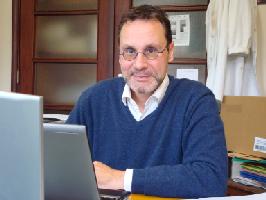Present research interests in Geology
There is, in the Geology Dept, a core business research focusing onto the mineralization processes in the Proterozoic mobile belts in Central Africa, e.g. in the Kibara (tin, tantalum, tungsten) and the Lufilian (copper, cobalt, uranium) Belts.
Together with enthusiast young (and less young) colleagues, Sophie Decrée, Stijn Dewaele, Florias Mees, I focus, since 2006, on an issue that was to some extent left behind: the formation of secondary ore deposits, especially in the Katanga Copperbelt. We revisited the formation of heterogenite (CoOOH or maybe HCo02), surface “cobalt caps”, malachite and of uranium minerals and deposits. Special attention was – and still is! – paid to the timing (age) of these events.
We now know that secondary ores essentially formed in a very recent (when compared to the 800My-old primary deposit) period, the Mio-Pliocene, and that they result from a series of processes in turn caused by a major uplift that affected most of Central Africa and started 10 millions of years ago. This uplift also results in the collapse and opening of fragile areas in the crust, and this process – still active – is well known as the “Great African Rifting”.
Interestingly, it is ultimately regional tectonics (i.e. geodynamics) that created the “window of opportunity” for the formation of secondary ore deposits in the Katanga (copper, cobalt, manganese), and most probably also in the Great Lakes area (yet to be demonstrated). It is also geodynamics that largely favored a stepwise remobilization of uranium in the Copperbelt.
The fate of uranium in the Katanga is a fascinating scientific issue: this deposit is neither very well known nor characterized, even if our recently published ages shed new light of remobilization events. But a series of question are still to be tackled: where does the metal ultimately come from? When and how does the primary deposit form? Is it synchronous with the Cu-Co deposit? And, last but not least, how does the metal behave now, in surface deposits that are easily accessible to the local population?
We have thus room for tackling a wide series of questions, either on recent geodynamics and ore formation in the Great Lakes area, the uranium cycling, the exposure of local population to the pollutant metals contained in surface ore caps, etc.
The latter research is the opportunity of a stimulating collaboration with medical doctors in the Université de Lubumbashi (RDC) and the Katholieke Universiteit Leuven (KUL), and takes place in a newly-fomed IGCP on the “Assessment of impact of mining and mineral processing on the environment and human health in Africa” (IGCP 594).
Present research interests in Geopolitics
It is virtually impossible to tackle the issue of mineral resources in Central Africa without looking at people living in these areas: poverty is appalling, and hundred of thousands of people (they even might be millions) are struggling for making some money with the exploitation and trade of mineral easily accessible, in surface deposits.
This issue results from a combination of factors: the area has experienced some of the bloody conflicts in the post-WWII period, many States are weak, corruption is commonplace, private companies are bitterly negotiating, and the high world demand for strategic commodities, as cobalt and tantalum, seems to justify commercial practices that are often detrimental to the local population, largely because the State stands no more as a protection for its own people.
Many parameters matter: the Museum has gained acknowledged expertise in the inner mechanisms at work in the Congolese State, the management of forestry, or the issue of environmental governance (Théodore Trefon). My personal interest of course goes to the mineral sector, and especially to the mechanisms that are emplaced to fight illegal exploitation of mineral resources, in the Great Lakes area.
African-based international conferences (such as the International Conference for the Great Lakes Area, ICGLR), business-driven initiatives (OECD), American laws (the Dodd Frank Act) are some of the pieces of this complex puzzle. Behind the scene, there is a wild scramble for mineral resources raging, between the old World, the United States and emerging super-powers. I try to give sense of all this in a forthcoming paper, to be published in 2012.
The question to solve is: is it possible to find a solution that is fair for the often forgotten actors, those living in these areas? In other words, is it possible to find solutions that are really sustainable, and will allow these countries to come permanently out of the vicious circle of starved and open conflicts?
Environmental governance becomes a matter of concern in areas where most urgent issues, as conflict and human rights violations, are not anymore the priority. Such is the case in Katanga, where we are still assessing the extent of the pollution resulting from a 100yr-long mining activity (see above).

